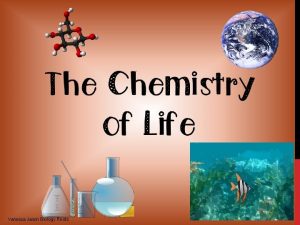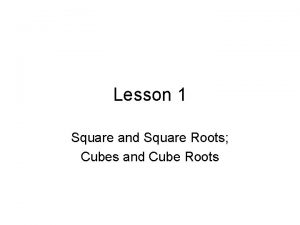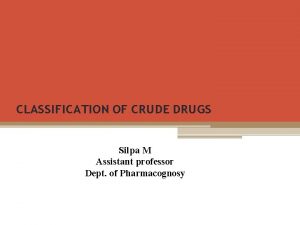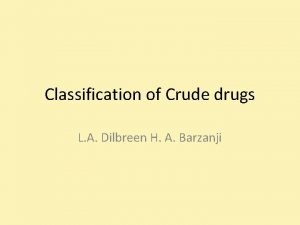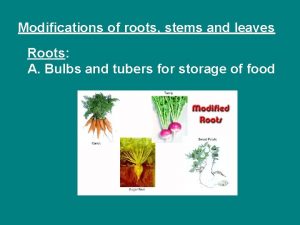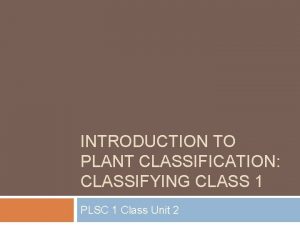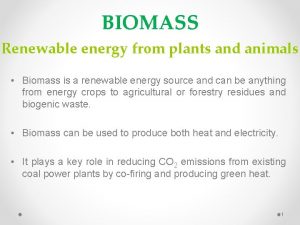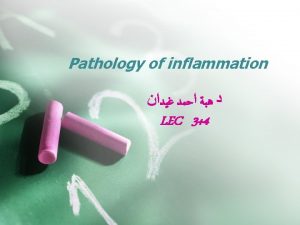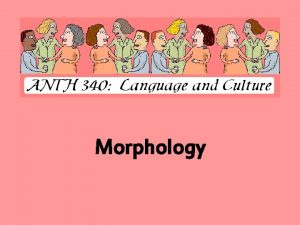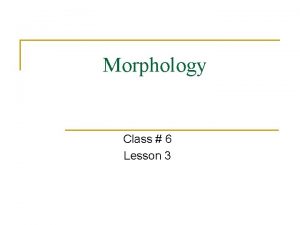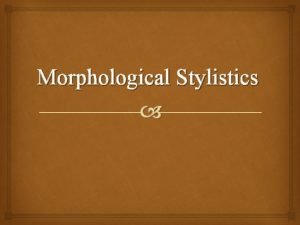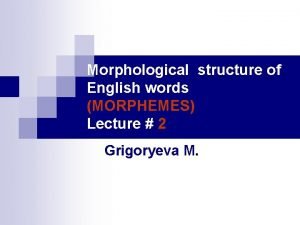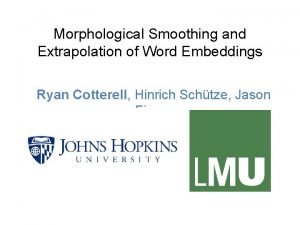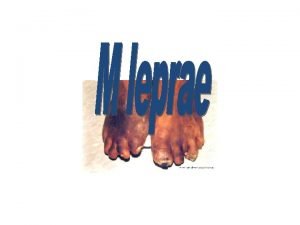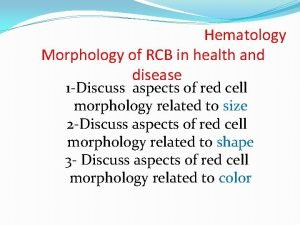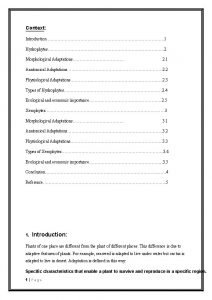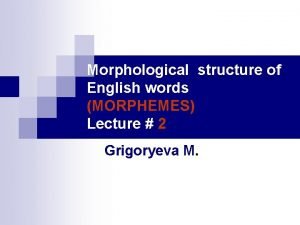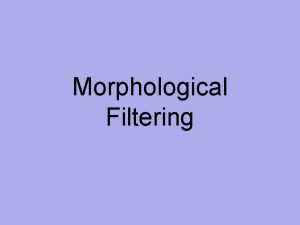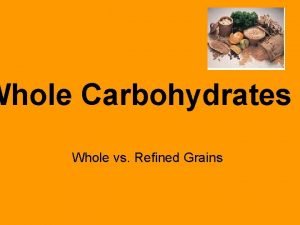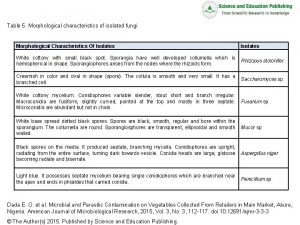PLANT SOURCE MORPHOLOGICAL CLASSIFICATION WHOLE PLANT Without roots







































- Slides: 39

PLANT SOURCE

MORPHOLOGICAL CLASSIFICATION WHOLE PLANT • Without roots - Alfalfa, Lobelia inflata, Ocimum sanctum • With roots - Aconitum napellus, Aethusa cynapium, Arnica montana, Belladonna, Chamomilla, Chelidonium majus, Conium, Drosera, Dulcamara, Euphrasia, Hyoscyamus, Hypericum, Ledum palustre, Pulsatilla, Ruta graveolens, Spigelia, Stramonium

ROOTS • Fresh : Arum triphyllum, Bryonia alba • Dried : Ipecacuanha, Ratanhia • Aerial : Ficus indica • Root & rhizome : Aletris farinosa

STEMS • Flowering stem : Cactus grandiflorus • Stem with leaves : Clematis erecta • Rhizome : Gelsemium, Helleborus, Podophyllum, Sanguinaria canadensis, Veratrum album, Veratrum viride • Corm : Colchicum autumnale • Bulb : Allium cepa, Allium sativum

LEAVES • Dried : Coca, Eucalyptus, Tabacum • Fresh : Digitalis purpurea, Rhus tox FLOWERS • Flower bud : Prunus spinosa • Stigma : Crocus sativus • Flowering heads : Cina, Calendula (with leaves).

FRUITS • Berry : Agnus castus • Nuts : Aesculus hippocastanum • Pods : Dolichos • Others : Capsicum annum SEEDS • Fresh : Avena sativa, Cucurbita pepo, Ignatia • Dried : Cocculus indicus, Coffea cruda, Nux moschata, Nux vomica, Sabadilla, Staphysagria

BARK • Fresh outer bark : Abies canadensis • Dried outer bark : Cinchona, Mezereum • Inner bark : Cinnamomum • Fresh bark of root : Baptisia tinctoria, Berberis vulgaris, Hamamelis • Dried bark of root : Gossypium herbaceum • Bark of root and stem : Robinia • Bark of trees : Azadhirachta indica, Jonosia asoka, Terminalia arjuna

EXTRACTS AND PLANT CONSTITUENTS • • Juices : Resins : Gum-resins : Balsams : Volatile oils : Fixed oils : Alkaloids : Aloe socotrina, Opium Abies nigra Asafoetida Balsamum peruvianum Oleum santali Oleum crotonis Atropine, Morphine, Nicotinum • Glycosides : Digitalin

COLLECTION AND PRESERVATION OF PLANT DRUGS • Supervision of a qualified and experienced Botanist. • Plants should be fresh, as far as possible. • Gathered from indigenous habitats. Wild plants are more effective and possess more medicinal value.

• Healthy, fresh and well-developed plants are selected. • Plants should be free from dust, worms and insects, plants spoilt by dirt and mud, withered, decayed plants with discolouration, abnormal odour should be discarded.

COLLECTION AND PRESERVATION OF PLANT DRUGS • Collected in fine, sunny, dry weather in early morning just after disappearance of morning dew. • Large amount of water should not be used for washing. • Exotic drugs should not be imported in powder form.

• For export, they should be tied in loose bundles. They should be packed loosely in botanical boxes. • Drugs can be kept fresh for a long time by keeping them in a cold storage. • Odorous substances should be kept in separate vessels.

WHOLE PLANT: In flowering season, when partly in flower and partly in bud during sunny weather. ROOTS: • ANNUALS: Early in autumn. • BIENNIALS: In the spring of the second year. • PERENNIALS: In the second or third year, before they develop woody fibers. STEMS: After development of leaves.

WOOD: In early spring or late in autumn before the juices are not exhausted. BARKS: • RESIN : In early spring, at the time of development of leaves and blossoms. • NON-RESIN : Late in autumn from young vigorous trees. HERBS: When they are fully developed, should be cut just above roots.

LEAVES: Just before and during early part of flowering time. Leaves of biennial plants are collected in spring of second year as soon as flowering stems begin to shoot. TWIGS: Of present year's growth only. FLOWERS: Partly in bud and partly in blossom, in dry weather.

BULBS : As soon as they mature when the leaves begin to decay. FRUITS AND SEEDS : When they are fully ripe. Succulent fruits, seeds or berries should be used while fresh. Only dried fruits, seeds or berries may be stored in well closed glass container.

PHYTOCHEMISTRY – ACTIVE PRINCIPLES OF PLANT DRUGS Phytochemistry is the chemistry of plants or chemical constituents of plants. It is the chemistry of natural plants used as drugs. The active principles of a drug are the potent constituents of the drug that is individual to the drug and are responsible for the pharmacodynamic action of the drug. Homoeopathy accepts a drug with its entity and totality without attempting to separate a drug into its specific chemical constituents.

CARBOHYDRATES Carbohydrates are the primary products of photosynthesis. They supply energy and are the structural or skeletal substances of plants (cellulose). They are precursors of biosynthesis of fats and proteins and of secondary constituents like alkaloids, glycosides. Carbohydrates are polyhydroxyaldehydes or polyhydroxyketones containing carbon, hydrogen and oxygen. They have a general formula Cn(H 2 O)n.

GLYCOSIDES Glycosides are organic compounds which on hydrolysis give rise to sugar and a non- sugar component Non – sugar component – aglycone Sugar component – glycone Therapeutic effect is due to aglycone part Glucose is the common sugar in a glycoside Glycosides can be hydrolysed by enzyme, acid or alkali Occur in fruits, seeds, leaves and bark of plants Most of the glycosides are colourless ( anthracin is red or orange and flavone is yellow)

GLYCOSIDES They are crystalline or amorphous solid substances soluble in water and alcohol. Insoluble in chloroform, petroleum ether Optically leavorotatory The name of all glycosides end in ‘in’. Classification of glycoside 1. O- glycoside 2. N – glycoside 3. S – glycoside 4. C - glycoside

GLYCOSIDES • • • Functions of glycoside Growth regulation and protection of plants Analgesic ( methyl salicylate of gaultheria) Laxative (aloin of aloes) Expectorant ( scilla glycosode) • • • Digitalis - digitoxin, digitalin Mezereum - daphin. Cinchona - quinovin. Aesculus hippocastanum - aesculetin Ruta graveolens - rutin. Thuja occidentalis - thujin, thujetin, thujenin

ANTHRAQUINONE DERIVATIVES • Are the active principles found in crude drugs • • • with purgative action Are derivatives of glycosides which on hydrolysis give a sugar and non sugar component ( aglycone ) Sugar is a pre – requisite for the pharmacological action of the glycoside Aglycone ( anthrone ) is the active part of the glycoside In the colon, bacteria hydrolyse the glycoside and reduce liberated aglycone to anthrone which act on intestine to stimulate peristalsis Seen in drugs like aloes, rhubarb, senna etc

SAPONINS • Are plant glycosides with characteristic • • • property of frothing ( saponification ) Are crystalline in nature Soluble in water Are hydrolysed to form sugar and non sugar components ( sapogenin) Drugs like sarsaparilla and senega have their medicinal property due to saponins Are toxic when injected and less toxic when taken orally Eg – digitonin in digitalis purpureae, cyclamin in cyclamen peltata

TANNINS Tannins consist of complex, organic, nonnitrogenous, phenolic compounds of high molecular weight. They possess the property to 'tan', i. e. to convert hide and skin into leather. Gives a protective function to bark • Hydrolyzable tannins : • • Rheum, Hamamelis Condensed tannins : Cinnamon, Cinchona Pseudotannins : Nux vomica, Ipecacuanha

RESINS • Resins are plant exudates, formed in schizogenous ducts or cavities • Resins are amorphous and transparent semi – solid and when heated melt and form a clear liquid • Insoluble in water and soluble in alcohol Physiological resins – produced as normal products of metabolism Pathological resins – formed as a result of injury to plants

RESINS Resins associated with volatile oil are called oleo-resins. Resins in association with both volatile oil and gum are called oleo-gumresins. If the resins contain benzoic acid and / or cinnamic acid and / or their esters, they are called balsams. • Gum-resins - Asafoetida Action of resins – purgative, cathartic, sedative, anti-helminthic, expectorant

ALKALOIDS Alkaloids are organic nitrogenous substances, more or less alkaline in action and are the secondary metabolites of a plant. Alkaloids means alkali-like. Alkaloids always contain carbon, hydrogen and one or more than one nitrogen, mostly oxygen and sometimes sulphur.

ALKALOIDS • The alkaloids are mostly active in their pharmacological behavior and most of them have an amino acids as their biosynthetic precursor. • Alkaloids are the active principles of many plants • First alkaloid was isolated by Serturner and was morphine from opium • They are extremely bitter but, some, like “piperine”, are tasteless

ALKALOIDS • Most are odourless but necotine have strong odour. • Many are deadly poison, but in minute doses, act as valuable therapeutic agents. • They are generally colourless, but a few are yellow, e. g. Berberine • Optically active – leavo rotatory • Chromatography is used for identification and isolation of alkaloids

ALKALOIDS • NAMING OF ALKALOIDS – name of alkaloid end in ‘ ine ’ • Botanical name of alkaloid yielding them – atropine from atropa belladonna, cocaine from coca • Physiological activity – emetine ( emesis) • Name of discoverer – alihirsultine, pelletierine

ALKALOIDS • DISTRIBUTION OF ALKALOIDS • Whole plant - lobelia inflata tylophora indica • Leaves – coca, rhus tox • Bark – cinchona, alstonia scholaris • Roots – ipecac, rouwolfia • Seeds – nux vomica, ignatia

PHARMACOLOGICAL ACTION OF ALKALOIDS Analgesic – cocaine, morphine Emetic – emetine Antihypertensive – reserpine Antimalarial – quinine Anti cancerous – vinblastine CNS stimulant – strychnine, brucine, caffiene • Mydriatic - atropine • • •

EXTRACTION OF ALKALOIDS • Is done by chromatography • Powdered drug is moistened with water • Mixed with lime which combines with acids and the alkaloids are set free • Alkaloids are made soluble in organic solvents like petroleum spirit to form alkaloid salts • Alkaloid salts are treated with acids in which salts are insoluble, so gets separated

• • • Belladonna: atropine, apoatropine Stramonium: hyoscyamine, hyoscine. Cinchona: quinine, quinidine, cinchonine Ipecacuanha: emetine Opium: morphine, codeine, thebaine, papaverine • Secale cornutum: ergometrine, ergotamine • Nux vomica: strychnine, brucine • Conium maculatum: coniine

• • • Aconitum napellus: aconitine, benzoylaconine Colchicum autumnale: colchicine Coca : cocaine Tabacuum : nicotine Coffea : caffeine Cina : santonine

VOLATILE OILS Volatile oils are odorous constituents of plants. They are liquid and volatile with a characteristic smell. They are characteristic of certain orders such as Labiatae, Rutaceae, Myrtaceae, Lauraceae, Piperaceae and Zingiberaceae. • • • Mentha piperita Camphora Nux moschata Eucalyptus Santalum album : Peppermint oil : Camphor oil : Nutmeg oil : Eucalyptus oil : Sandalwood oil

FIXED OILS, FATS AND WAXES Fixed oils and fats, obtained from plants, differ only as regards their melting point but chemically they belong to the same group. If a substance is liquid at 15. 5 to 16. 5 , it is called fixed oil and if it is solid or semi-solid at the above temperature, it is called fat.

If a small quantity is placed on paper they produce a permanent translucent stain on the paper and consequently they are called fixed oils. Ricinus comunis: Castor oil Croton tiglium : Croton oil Hydnocarpus : Hydnocarpus oil

RESINOIDS • Are the precipitates in powder form obtained by mixing a strong alcoholic tincture of a plant with 3 to 4 times its bulk of purified water • All alcohol – soluble substances are precipitated • The precipitates are collected, dried and pulverised and are called resinoids • Resinoids were used at a time by eclectic physicians • Now a days mother tinctures are used instead of resinoids
 Whole school whole community whole child model
Whole school whole community whole child model Massed practice
Massed practice Vanessa jason biology roots www.biology-roots.com
Vanessa jason biology roots www.biology-roots.com Square root notes
Square root notes Existence and uniqueness of square roots and cube roots
Existence and uniqueness of square roots and cube roots The roots of american imperialism economic roots
The roots of american imperialism economic roots Quadratic equations with fractions
Quadratic equations with fractions Cube numbers list
Cube numbers list Merits and demerits of pharmacological classification
Merits and demerits of pharmacological classification Morphological classification of crude drugs
Morphological classification of crude drugs Poem without title
Poem without title Without a title poem
Without a title poem Justify the title keeping quiet
Justify the title keeping quiet Root stem leaf
Root stem leaf Plant classification worksheet
Plant classification worksheet Educating the mind without educating the heart
Educating the mind without educating the heart Plants need nitrogen
Plants need nitrogen Biomass energy advantages
Biomass energy advantages Branches of stylistics
Branches of stylistics Morphological patterns of chronic inflammation
Morphological patterns of chronic inflammation Morphology
Morphology Example of morphological process
Example of morphological process Morphology meaning in marathi
Morphology meaning in marathi Morphological tree diagram
Morphological tree diagram Morphological stylistic devices
Morphological stylistic devices Semi bound morpheme
Semi bound morpheme Morphological smoothing
Morphological smoothing Morphological forms of inflammation
Morphological forms of inflammation Natorial legs
Natorial legs Bacteriological index vs morphological index
Bacteriological index vs morphological index Low iron causes
Low iron causes Verbal compounds examples
Verbal compounds examples Morphological types of anemia
Morphological types of anemia Morphological antialiasing
Morphological antialiasing Digital image processing
Digital image processing Morphological watershed
Morphological watershed Hydrophyte adaptations
Hydrophyte adaptations Morphological chart for bicycle
Morphological chart for bicycle Semi-bound morphemes
Semi-bound morphemes Semantic fossilization
Semantic fossilization


